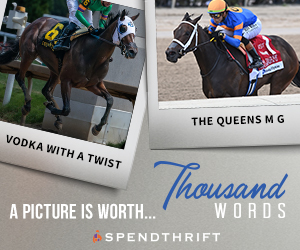
To B or Not to B
Two of the biggest mistakes handicappers make are properly identifying a “track bias” and understanding the whole “bounce” theory and what it is and actually means. Understanding these aspects of “betting” will improve your game significantly. Hopefully this article will help.
The key word there was “betting” and I point that out for a reason. If bettors who have live skin in the game make mistakes, and have difficulties truly understanding and dissecting these two vital aspects of the game, can you imagine how the casual fan, and even most bloggers, especially those who don’t bet seriously, totally make conundrums out of them.
People read these “blogs” and social media comments, and take it like many take the news, as if it’s fact. Often it isn’t and one of the many issues our game faces is trying to bring new and young blood into the sport. Unfortunately, they have to properly identify their customers before they do that, and give them what they want. Social media has created a platform in which anyone can declare themselves an expert, or write in a manner that suggests it, at times even if that is not their intention, and people will believe it the same way they automatically believe the news, because someone on the television said it, or some reporter or journalist wrote it. The industry, and even the few outside publications that still cover it, are beginning to promote this, and that can be problematic and have the reverse effect in the long run.
Sticking to our game, “The Sport of Kings” , it’s difficult to have legitimate meaningful opinions on certain aspects of horse racing unless you actually bet and have skin in the game. It’s the only way you can learn it. It’s not taught in schools, and you can’t learn it from any book. It’s hands on. The industry misses that and promotes people they think will bring the new desired young blood into the sport, and it may to a small degree, but often at what expense. They are providing information that makes a game that is already difficult to beat even more difficult.
Make no mistake horse racing is a skill game, just like poker, and only about 10% of the people who play it regularly beat it. There are many reasons for that. Talent, money management, handicapping prowess, ticket structure, lack of discipline and many others, unfortunately one of which is the self or industry promotion of experts who aren’t. The two examples I’ll use are “track bias” and “bounce”, but we’ll get back to that. First I want to get opinion and subjectivity out of the way.
So much of our game is subjective. The stewards prove that daily with inconsistent decisions. I am all for respecting others opinions, but that doesn’t mean they can’t be wrong. I also think some things we accept as opinion actually aren’t and the subjectivity invoked by them is just an argument based on lack of knowledge and true understanding. As they say, let the buyer or in this case reader or listener beware. You can argue with me all day a Volkswagon is faster than a Ferrari. You are certainly entitled to that opinion and some will say it can even be subjective. I don’t. The Ferrari is faster, plain and simple and if you make great points about the Volkswagon, they won’t help it win the race. You are just wrong. If you think the comparison is extreme, I say that is good, we are on the same page at least for now.
I think the misconceptions the experts talk about “track bias” and the “bounce” are just as extreme and just as wrong. Further if the Ferrari breaks down, and the Volkswagon wins, you were still wrong, the Ferrari is faster and a broken clock is right twice a day, but still broken.
As soon as a few horses go wire to wire you’ll hear and see the comments start. Speed bias they will say. The track is favoring speed. Bet the speed. It’s almost always premature, and even more importantly, based on an improper evaluation. For example, let’s say the first five races are won wire to wire, and in two or three of those races, the second place finisher was second all the way around. Obviously, there is a clear speed bias here right? Well there must be as 90% of the bloggers will tell you there is and point out the above example results, and the self-proclaimed experts will be all over it on social media, and even the experts prematurely promoted by the industry will jump all over it to clearly demonstrate their knowledge and expertise. You have all seen it before, it will be all over the place. So are they right? Don’t they have to be, all those great minds? No. They don’t and might not be. They might be just like the broken clock arguing about the Volkswagon and Ferrari, but nobody knows that yet. Those results isolated by themselves don’t tell us what many would have you believe they do.
The first question you must ask is how many of those horses were best that day and supposed to win? How many were lone speed? How many of those races had other speed that didn’t go? Did any of those races have closers who had trouble or bad trips? All this must be looked at and in detail prior to declaring any track bias, let alone wagering to gain an advantage because of it. There may be no track bias at all. The first five wire to wire winners, along with the three merry go round second place finishers tell you nothing. The bloggers and experts think they know, and they seem to love to inject the word “fact” as if the insertion of that word makes it not opinion. They’ll argue “look the facts speak for themselves, the first five races were wire to wire, that is a fact, hence the speed bias exists.” The bettor in me wants to stay quiet and let them go on thinking they are track bias masters, but you deserve better, and the fact is in all likelihood the bulk of them and their readers couldn’t dent a pool with a hammer.
Now I think we can all agree this past Saturday, Belmont Stakes Day, was one of the most competitive days of racing we will see all year. Championship quality. The best of the best, all at their peaking best. The track bias was easy to identify, it was strong, and if you saw it, you were able to capitalize and make money off it, which – “newsflash” – is what it is all about. When you have a card like that, it’s easier to spot things than say when you are grinding out a late pick 4 on a cold Ozone Park afternoon at the Big A. Further if you’ve never done that, or you don’t recognize the sound of programs and forms being rolled up into whips and used by bettors to ride their wagers home then you likely can’t spot a real track bias or bounce anyway. Even Harvard can’t teach you that. You have to bet with skin in the game to really see it and learn it. That should be the criteria the industry uses to put forth experts opining with people listening in their failing attempt to get new and young blood into the stands. Don’t shun the gambler, embrace them as poker did, and maybe you can charter a boat like the one they caught and you missed.
Back to The Belmont Card. There was a strong closers’ bias, and it was evident early and all day. It was the kind of track bias that can make you money if you play it right. You see, a real track bias, a strong track bias, will make horses win who would not have won without it, and will make horses lose who would have won without it. That’s the other question you have to ask when determining if a bias is real or an illusion. How many fit into either category. You have to be a handicapper and a decent one at that to know that answer. That eliminates a lot of people from coming up with the right answer.
Every single dirt race was won by horses coming from off the pace. Most of them from considerably off the pace. If you applied the above questions, the answers confirmed there was indeed a track bias. First off, we are talking every single dirt race on the card. Indeed, there were horses who won because of the bias, and horses who lost because of it. It was not illusionary, and properly understanding and charting it will lead to major horses to play and play against.
It began in race 1 when odds on favorite Cupid and second choice Rally Cry were swallowed by Economic Model, a horse I gave out as a play in our Belmont webinar. I did not know at the time he would be bias aided, and didn’t know it when I watched the race live. He was though, and the speed horses were hurt by it. It continued in the second race when Connect rallied from off the pace to win.
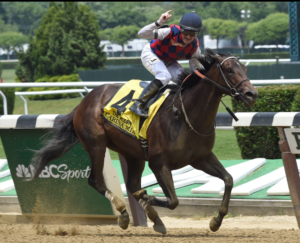
The third race was The Grade 1 Acorn, and Carina Mia took it, but not with the early speed we were so accustomed to. Apparently, she learned to come from behind in her prior Keeneland win, and looks like she is even more effective that way. She easily handled Cathryn Sophia, The Oaks winner, Go Maggie Go, The Black Eyed Susan winner, and the highly regarded Off the Tracks. The exacta was also given out in our webinar. The Brooklyn winner, Shaman Ghost rolled from off the pace, and Cavorting rallied from off of it to take The Ogden Phipps. Tom’s Ready came from way back to take The Woody Stephens. Frosted exploded from off the pace to romp in The Met Mile, and even bias aided, the performance was one for the books. I’d pay particular attention to the speed horses coming out of that race. I’d upgrade “BIG TIME” any speed horses who faded on Belmont Day next time they run back.
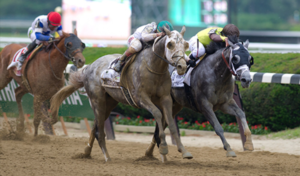 By the time The Belmont rolled around, Creator had to be looking very good if you were paying attention. This was a prime example of a time when an audible had to be called. If you liked a speed horse in The Belmont you were in trouble. Gettysburg being entered as a rabbit for Creator had absolutely nothing to do with it either. A closer, likely a deep closer was going to win The Belmont. I had earlier narrowed the race down to 5 horses I thought could win: Destin, Suddenbreakingnews, Stradavari, Exaggerator, and Creator. Creator was as good if not better than any of them in my opinion.
By the time The Belmont rolled around, Creator had to be looking very good if you were paying attention. This was a prime example of a time when an audible had to be called. If you liked a speed horse in The Belmont you were in trouble. Gettysburg being entered as a rabbit for Creator had absolutely nothing to do with it either. A closer, likely a deep closer was going to win The Belmont. I had earlier narrowed the race down to 5 horses I thought could win: Destin, Suddenbreakingnews, Stradavari, Exaggerator, and Creator. Creator was as good if not better than any of them in my opinion.
Before I realized how strong the track bias was, I decided to narrow the race down to 2 horses, Stradavari and Creator. By race time, I knew including Stradavari was likely a mistake, but I was still able to capitalize on Creator winning and put myself and The Twin Spires Players Pool each in a good position. We were both alive to a closer in the last race, the fastest closer in the last race, Watershed. A funny thing happened on the way to the last race however, it rained. I do not think the rain changed the bias, which it easily could have, but I do think it prevented Watershed from winning. Watershed, who was a game changer for both The Players Pool and me, didn’t seem to get a hold of the wet fast track down the backstretch. He was climbing, and did not have good action. He went real wide, and closed fast for third once he got a hold of the track, galloping out well in front, but he didn’t deliver. Not to make excuses, but if it doesn’t rain I think he inhales them and the day goes from really good, to real great. The winner of course came from off the pace and moved up over the wet going.
I’ve written about “the bounce theory” before, and it is no secret I believe in it. It’s also no secret I think a lot of people misuse the term, don’t understand what a true bounce is, and couldn’t see one coming if they were in front of a bus with binoculars. Again we understand all about respecting the opinions of others, and we should. That doesn’t make them right. The Ferrari’s still faster. I never understood how people make predictions about races months in advance before they are even drawn. Granted, there are isolated exceptions.
After The Peter Pan I wrote California Chrome was in trouble and I thought Tonalist would win The Belmont. One horse, one race, isolated, and I knew he was being pointed for it by a master in Christophe Clement. That’s a tad different than saying Frosted won’t lose again all year, which I recently saw an “expert” opine. Even if you turn out right, the statement, in my opinion, just shows a total lack of understanding of the game. It’s out there though, I saw it in more than one blog, you know those things experts write. Worse, I read where someone said he (Frosted) was not likely to bounce next out because he has a good foundation. I didn’t know what to say other than would you like to buy a Volkswagon that’s faster than a Ferrari? I mean what can you say. Yes, Frosted is likely to run a 8- on Thoro-Graph again next out. Not only is that far beyond likely it borders on impossible. It was a freakish effort that was aided by the track bias. Taking nothing away from the extraordinary race Frosted ran, he did so under optimum conditions and it was an effort few if any horses repeat. Regression is almost guaranteed. A total bounce is likely and noted is Frosted has regressed off his new tops before. Why wouldn’t he off this huge jump forward? If you think it’s because he had a foundation, sorry, that helped him run that race, it won’t help him repeat it or avoid bouncing.
In fairness, and to be clear, let’s define a bounce. A bounce is when a horse regresses off an unusually big effort (a monster race falls into that category) that includes a new top figure on Thoro-Graph or The Rags. It starts with a significant forward move, followed by a notable regression. You can bounce and still win. If you don’t use either of those products, and rely on raw speed figures that do not account for trip, then you won’t recognize or become familiar with a bounce pattern most of the time, unless you are a really astute handicapper.
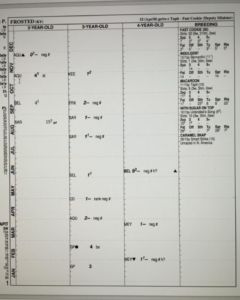 I’ve included Frosted’s Thoro-Graph sheet after The Met Mile. It screams bounce. He may not run close to that again all year. Sometimes a horse can bounce off a few strong efforts in a row. That usually occurs when they run back after one too quickly, or the trainer goes to the well one too many times. Another misconception about the bounce factor, is that if a horse wins easy, ears pricked, throttled down, they are less likely to bounce. Nonsense. A fast race always takes a toll, no matter how easy it looked.
I’ve included Frosted’s Thoro-Graph sheet after The Met Mile. It screams bounce. He may not run close to that again all year. Sometimes a horse can bounce off a few strong efforts in a row. That usually occurs when they run back after one too quickly, or the trainer goes to the well one too many times. Another misconception about the bounce factor, is that if a horse wins easy, ears pricked, throttled down, they are less likely to bounce. Nonsense. A fast race always takes a toll, no matter how easy it looked.
Another one that caught my eye was Beholder showed she finally lost a step in The Vanity. Without even touching on whether or not that is accurate, the fact is nothing in The Vanity evidenced it. If you think it did I am not sure what past performances you use or what race you watched. She won easily, under wraps, throttled down, toyed with Stellar Wind, and was far from 100% cranked up. Richard Mandela is a master at pointing for specific races and having his horses peak for them. He’s done it many times and is as good as anyone at it. Do you think for one second The Vanity was one of the major goals for this champion 6-year-old mare? I don’t. He probably has two major goals or spots picked out, and she ,barring any setbacks will peak for those. You can also factor in Gary Stevens knows a thing or two about saving a horse and only using as much gas as he needs. Beholder looks as good as ever to me, and if she has indeed lost a step, it was not visible in The Vanity and that easy win. If all that is not enough, note the following: Beholder ran the last 1/16th of a mile in The Vanity in 6.2 seconds. The only last 1/16th she ever ran faster was early in her career when she did it in 6 flat. She was two at that point, she’s 6 now. She ran the last half in 46 and change. Still think she lost a step?
With all these chefs in the kitchen, the soup is bound to turn out salty. While there are many great, knowledgeable, well informed horse racing bloggers out there, along with many great analysts, reporters, columnists, handicappers, and journalists, it gets discouraging when racetracks, magazines, ADW’s, networks, and other forms of media promote as experts those who are really novices, and primarily people who don’t have real betting experience. While the outlet social media has created can’t really be controlled, the more professional outlets, and those tied directly to the game can. We even have major racetracks playing beat the experts, with one problem, the experts are novices. What’s wrong with that picture? It reminds me of when someone voted for California Chrome to win The Eclipse Award for turf horse off that one win, somehow thinking Main Sequence going 4 for 4 on the year in the US, and winning The Breeders’ Cup Turf against the best, played second fiddle. Should that person have a vote? While respecting everyone’s opinion, that one was just wrong.
Perhaps the most comical one of all is a story about the magnificent mare Tepin. What an example of a mare who has simply developed into something special. She’s held her spectacular form for a while now, and it includes wins in The Breeders’ Cup Turf Mile against males, and The Group 1 Queen Anne for her seventh win in a row. Spectacular resume, and all credit where credit is due for taking her game on the road to prestigious Royal Ascot to run straight, without Lasix she is accustomed too, without a nasal strip, over soft ground, and even slightly uphill. It did not stop her from becoming the first American based winner of The Queen Anne. Not many American horses try Royal Ascot, but in the small sample there has been success before. Undrafted won a Group 1, The Golden Jubilee, and Acapulco won The Group 2 Queen Mary, both for Wesley Ward. Animal Kingdom tried The Queen Anne without success a few years ago, and Ken McPeek tried The Coronation with Rosalind who unseated her rider a few years back as well. There have been a few others that have tried the meet, but overall it is a small sample from which there has been some success. Taking nothing away from anyone to compare Tepin’s victory in The Queen Anne to American Pharoah’s Triple Crown, or any Triple Crown winner is comical. It warrants no response. It’s out there though, in more than one sense if you get my meaning.
I guess it all comes down to let the buyer, or in this case reader or watcher beware. Just because something is in print, or published doesn’t give it credibility. Unless you have been in the trenches and paid your dues, this is a tough game to really understand let alone write about with intelligence and more importantly with credibility. There are certainly many who do, but at this point I’m afraid there are more who don’t. It’s all the more reason to appreciate the ones who do, and share that knowledge and experience. That helps the game, not gibberish. Everyone has an opinion, you can certainly respect them and their right to have one, but that doesn’t make them right or credible. The real horse players can usually tell the difference, if they bother to read that stuff at all. Considering how many papers are dropping racing coverage, and the response all these new experts are receiving from bettors, I tend to doubt it.
High Five
Irad Ortiz Jr. for a Belmont winning ride that is right up there with the best of all time. He made three different perfect moves, all of which combined won him and Creator the race. First Irad got Creator from the far outside to the inside without even altering his stride for a second. When a horse was inside of him he just eased Creator back a bit, and got him over. He kept him close enough not to leave him too much to do sensing the pace perfectly. Turning for home he never checked or lost stride while looking for his hole and picking his paths. It was beautiful to watch and handled expertly. He went just far enough outside Governor Malibu to get around him without checking but without losing an inch more than he had to. When he got his chance to split horses and go for it, he went right to it and when it came time to get down low and go to work against Javier he did. If he hesitated, went wide, or checked, the order of finish is reversed. The jockey matters.
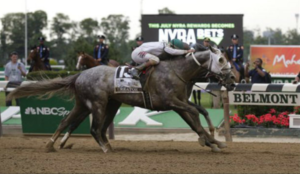
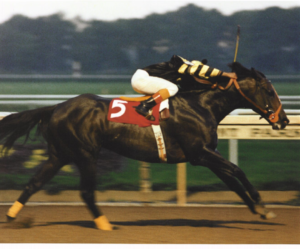
What better compliment can you give a young rider than putting his picture next to the iconic photograph of Angel Cordero Jr., showing horse and rider as one. Anyone see the similarity I see? You cannot look better on a horse. Irad, congratulations, go and buy you and Jose some new sunglasses, you both will need them, the future is very bright!
Low Five
Those who write about betting on horses, without actually betting on horses.




